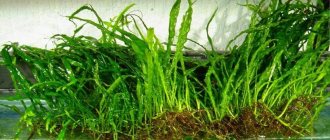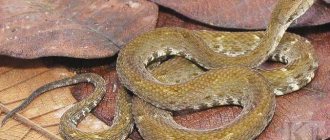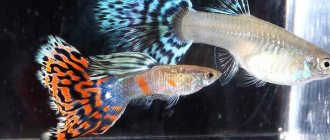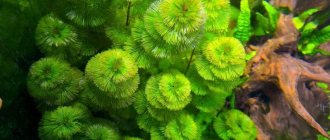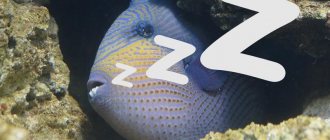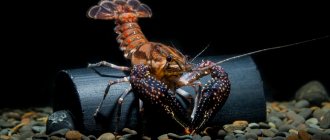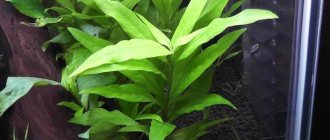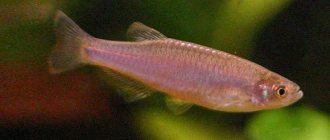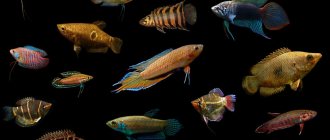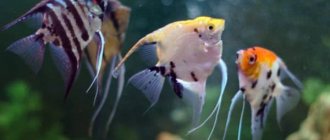Thai fern is a very popular aquarium culture. Its wide distribution is largely due to its unpretentiousness and excellent adaptability. The plant grows well, does not need fertilizer, does not need additional lighting, and is a great companion to various aquarium inhabitants. The Thai fern looks very nice. Its size, shape and color of leaf blades may vary depending on the variety of the plant itself.
Habitat and appearance characteristics
The Thai fern is native to Asia. Belongs to the centipede family. Can grow both on land and in water. An attractive aquarium culture that forms dense thickets. No special requirements for soil, lighting, free space.
The foliage of the Thai fern has a bright green color, growing quickly to form a beautiful, dense shrub. The average height is about 20-25 cm.
Develops evenly throughout the year. Perfectly suitable for decorating and decorating any artificial pond plan. The crop propagates vegetatively.
Reproduction
This process is not particularly difficult. The main thing is to provide suitable conditions of detention. If you plant a Thai fern on a snag or stone without disturbing it, then over time it will begin to multiply on its own. First, you can take small bushes of 2-3 leaves and plant them at a short distance.
Close-up of baby angustifolia fern.
As they adapt and begin to grow, shoots will begin to appear on older, larger leaves. In this case, the mother leaf turns black and gradually dies. As soon as it dissolves in water, the young bush will detach and can be planted separately. If the owner of the aquarium has not yet decided on the location, then the shoot can be left untouched. It won't die if it just floats around the container.
Conditions of detention
The Thai fern can easily be classified as the most unpretentious, unpretentious aquarium crop. This plant does not need soil.
It is strictly forbidden to bury seedlings in the ground, but they will feel great tied to snags and underwater pebbles. Thick threads and fishing lines are perfect for these purposes, which aquarists prefer to use due to their inconspicuousness in the water.
The slow growth rate makes the fern a suitable decoration for even small aquariums. In addition, this feature eliminates the need for aquarium owners to regularly thin out and trim the tops of the plant.
The Thai fern does not need too much light and tolerates shade well. But excessively intense illumination, on the contrary, can harm it, causing damage, thinning and darkening of leaf blades.
It is recommended to use weak fluorescent lamps for additional lighting.
Daylight hours should last at least 12 hours; only in this case can you count on the formation of a beautiful, healthy shrub with bright, eye-catching foliage.
Since the plant receives most of its microelements and nutrients from water, it will respond well to additional liquid fertilizers. It is recommended to fertilize regularly after cleaning the pond and changing the water. It is important to use the liquid form of fertilizer; tablet preparations for Thai fern will be useless due to the lack of rhizomes.
The best habitat for an aquatic plant will be soft, moderately acidified water. However, the plant is quite resistant to changes in these indicators. The same applies to temperature conditions.
However, it should be remembered that when the water cools to +18°C and below, the growth processes of the Thai fern slow down and then stop altogether.
Description
In nature, this underwater flora, as you might guess, is found in the waters of Thailand and other countries in Southeast Asia. But their main difference from the aquarium species is that in rivers one bush can reach 50 cm in height. At home, this figure is, at best, half as much, but most often the plant grows up to 10 cm and no more.
Microzorium (biological name) is extremely interesting because it does not need soil at all for good growth. He simply looks for food in water. As a rule, in rivers this plant attaches itself to stones and snags, and holds on to them very tightly thanks to its long thread-like roots.
The bushes have elongated green leaves and a thin creeping stem. They reproduce quite interestingly. Young shoots appear directly on the leaves. When they grow and take root, the leaf on which they grew turns black and dies.
When the young shoots grow and take root, the leaf on which they grew turns black and dies.
What problems may arise
Thai fern is hardy and stress-resistant. The main problem that aquarists face when growing plants is a slowdown in growth caused by a deficiency of nutrients and valuable microelements. This can be avoided by applying liquid fertilizers in a timely manner.
In addition, it is necessary to monitor the acidity of the aquatic environment, since when it increases strongly, the fern leaves begin to turn black and deteriorate. When digging up the ground, bottom-dwelling fish can damage and injure the weak roots of an aquatic plant, preventing its growth and reproduction, so it would be better to avoid such a neighborhood.
Cryptocorynes
Now - cryptocorynes . The vast majority of these amazingly diverse aroid plants, although they live in nature mainly along the shores of reservoirs, feel great when kept underwater. They are planted directly into the ground, placing the growing point (the core of the rosette) approximately at the level of the gravel surface. Unlike, for example, Echinodorus, Cryptocorynes do not shed damaged roots after transplantation, but preserve them, easily coping with their breakage. Therefore, the roots of these plants that are too long can be trimmed without fear with scissors before planting - this will not be a big injury for Cryptocoryne. But many cryptocorynes can partially shed their leaves due to stress during transplantation. Do not be alarmed by this phenomenon - very soon the leaves will grow again, larger and more beautiful than they were. Many species of cryptocorynes reproduce by stolons, similar to the “whiskers” of garden strawberries. Only, unlike strawberries, stolons do not spread over the surface, but inside the soil. So don’t be surprised if, after some time, you suddenly start to sprout here and there, sometimes quite far from the mother plants, small cryptocorynths. Large cryptocorynes are planted in the middle and background, filling the visual “bald spots” in the design with them, and small species are planted forward, not far from the viewing glass.
- Cryptocoryne Valkera yellow
- Cryptocoryne splendor
- Cryptocoryne Walker
- Cryptocoryne Wendta green
- Cryptocoryne curly
- Cryptocoryne related
- Cryptocoryne related
- Cryptocoryne ciliata
- Cryptocoryne pontederifolia
- Cryptocoryne Vendta dwarf
- Cryptocoryne Willis
- Cryptocoryne small (dwarf)
- Cryptocoryne hybrida
- Cryptocoryne Beckett
- Cryptocoryne cordate Blassa
- Cryptocoryne cordate
- Cryptocoryne Wendta brown
Why is it useful?
The Thai fern is characterized by the presence of the following useful qualities, which determine its popularity among aquarists:
- creating a beautiful aquarium design without unnecessary effort;
- release of large amounts of oxygen;
- the formation of bushy thickets, extremely comfortable for resting, playing and breeding of small fish and fry;
- water purification, performing a filter function.
This culture, despite its unpretentiousness, with proper planting and reasonable care, looks very attractive and creates an impressive design.
Spreading
The natural habitat of Microsorum pteropus is Malaysia, Thailand, northern India and some regions of China.
In Europe and America, the Thai fern is better known as Java fern or Java fern.
This is due to another place of its distribution - the island of Java in Indonesia.
In nature, it attaches itself using its root system to stones, roots or tree trunks. Sometimes you can find a plant immersed in the substrate.
This fern grows like a weed, so in its natural habitats there are no clear indications of its preferred conditions - water quality, amount of light and flow. In nature, some types of ferns can be found near waterfalls, rivers or streams in tropical forests.
How to plant correctly
Thai ferns grow well in any soil. For the full development and formation of the bush, it is recommended to tie it to stones and snags.
Since the aquatic plant performs a filtering function, many aquarists prefer to place it in the center of the reservoir for complete water purification. The aquarium can be of any size, but the plant thrives and looks best in deep and spacious containers.
Benefits for the aquarium
Fern is a purifier of any body of water, especially a small one. During its life, it absorbs substances of any origin. To improve water quality and expand the area of influence, it is recommended to plant young bushes in the center of the aquarium.
Ferns are used to create interesting compositions and unique underwater designs.
In this photo, a pair of angelfish spawned and fertilized eggs on a fern.
Adult fish often prefer to spawn in already grown fern leaves. Babies hide in green thickets from predators, and viviparous fish prefer to give birth to their young there.
Compatibility with aquarium inhabitants
The Thai fern is one of the few plants that is not dangerous in the vicinity of goldfish. It is not recommended to plant it in an aquarium with such inhabitants as catfish, corydoras, agamixis, which belong to the category of bottom fish and can damage the fragile, poorly developed rhizome of the plant.
Because of its harshness and bitterness, Thai fern is not liked by herbivorous fish.
Therefore, it perfectly coexists with guppies, swordtails, and angelfish. Snails and various mollusks are also not afraid of the Thai fern.
As for other aquarium crops, ferns, due to their compact size, get along well with most plants, including light-loving ones. It goes well with tall and spreading shrubs, as it is resistant to shading.
Thailand fern is one of the most popular aquarium plants. Its advantages include an attractive appearance, ease of use, slow growth, shade tolerance, and the ability to perform numerous useful functions, including filtration and natural purification. A large number of varieties allows each aquarist to choose the most suitable option for himself in terms of color, growth rate and size.
Plant varieties
Breeders have managed to develop many varieties of ferns, among which the most popular are: angustifolia fern, Vindelov fern and Trident fern.
Narrow leaf fern or Microsorum pteropus "Narrow leaf"
Thailand narrow-leaved fern is the name of several varieties that have long, narrow leaves. In European countries, the “Narrow leaf” variety, bred by Tropica in Denmark, is sold under this name. The leaves of the plant are light green, 1-2 cm wide, 20-30 cm long.
In Asian countries, a fern called “Taiwan” is popular. Its leaves grow up to 45 cm in length and only 3-5 mm in width. A fern called “Needle leaf” has a similar leaf shape. These two species can be distinguished by the presence of brown fibers on the axial central vein of the second.
The developed varieties are unpretentious to the conditions of detention. The roots grow to hard surfaces and grow at water temperatures from 4 to 30 degrees. Light level doesn't matter. Comfortable water hardness dGH 0-14 degrees.
Vindelov fern or Microsorum Pteropus "Windelov"
Vindel fern was bred in Denmark at the Tropica nursery. The name of the plant is given in honor of Holger Vindelev, the founder of the company. The height of an adult bush is 15-20 cm. The leaves are lanceolate-shaped and dark green. The tips of the leaves are divided into several branching processes, forming something like a bunch. The content is simple: water temperature 4-30 degrees, hardness dGH 0-14 degrees, acidity pH 4-7.5. Lighting can be anything.
Trident fern or Microsorum pteropus "Trident"
This is a natural variety of Thai fern that grows on the island of Borneo. The Trident fern forms a creeping shoot with many narrow long leaves, on which lateral shoots grow on each side. The height of an adult bush is 15-20 cm.
It is not demanding in terms of content: water temperature 4-30 degrees, hardness dGH 0-14 degrees, acidity pH 4-7.5. Lighting can be anything.
Photo of Thai fern
Hornwort
Hornwort dark green
Well, the last plant that we will need temporarily, at the first stage of the life of the aquarium, is the common hornwort . Big good bun. This unpretentious cosmopolitan plant, not distinguished by high aesthetic qualities, has one very important property for the successful start of an aquarium - it grows very quickly. So quickly that in the starting period, when the permanent plants are still sick, taking root and experiencing stress from transplantation, it takes over the initiative and does not allow lower algae to develop, starting the biochemical cycle of the aquarium.
Hornwort light green
© Aqua Logo Andrey Klochkov
To be continued…
The first part is devoted to preparing a “slow aquarium”, the third - the process of creating it, and the fourth - suitable fish for it.
Fields marked with * are required.
